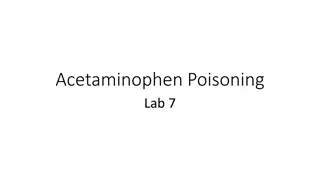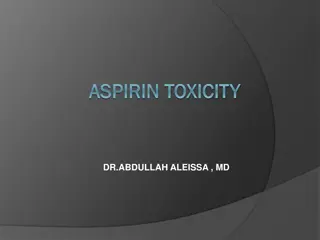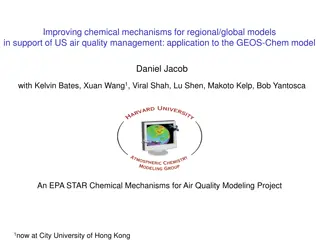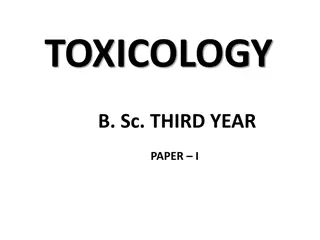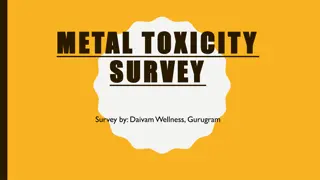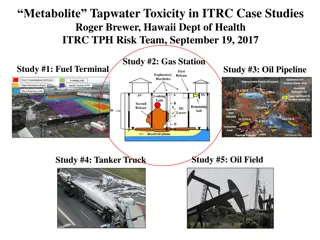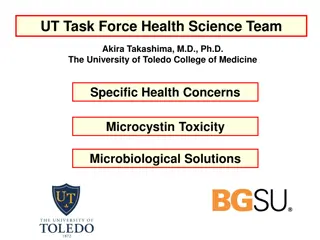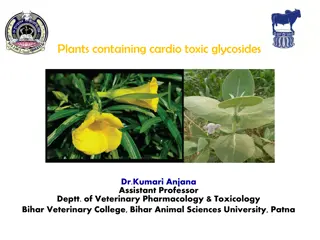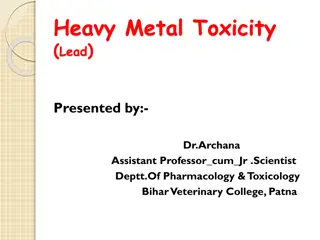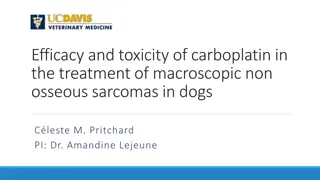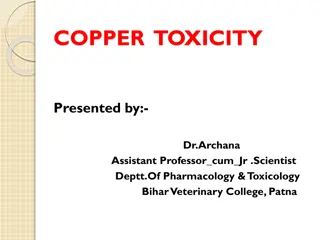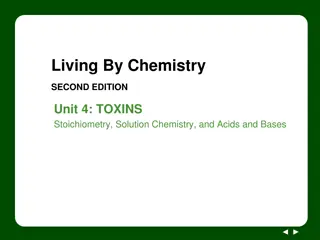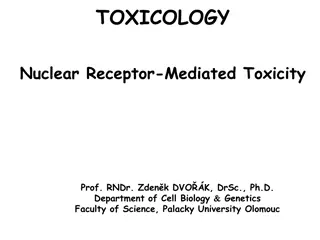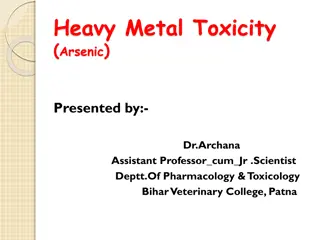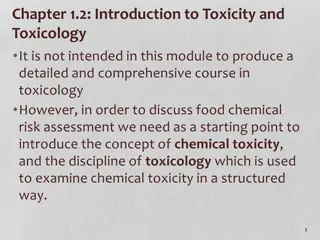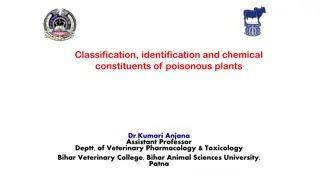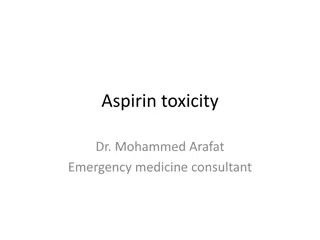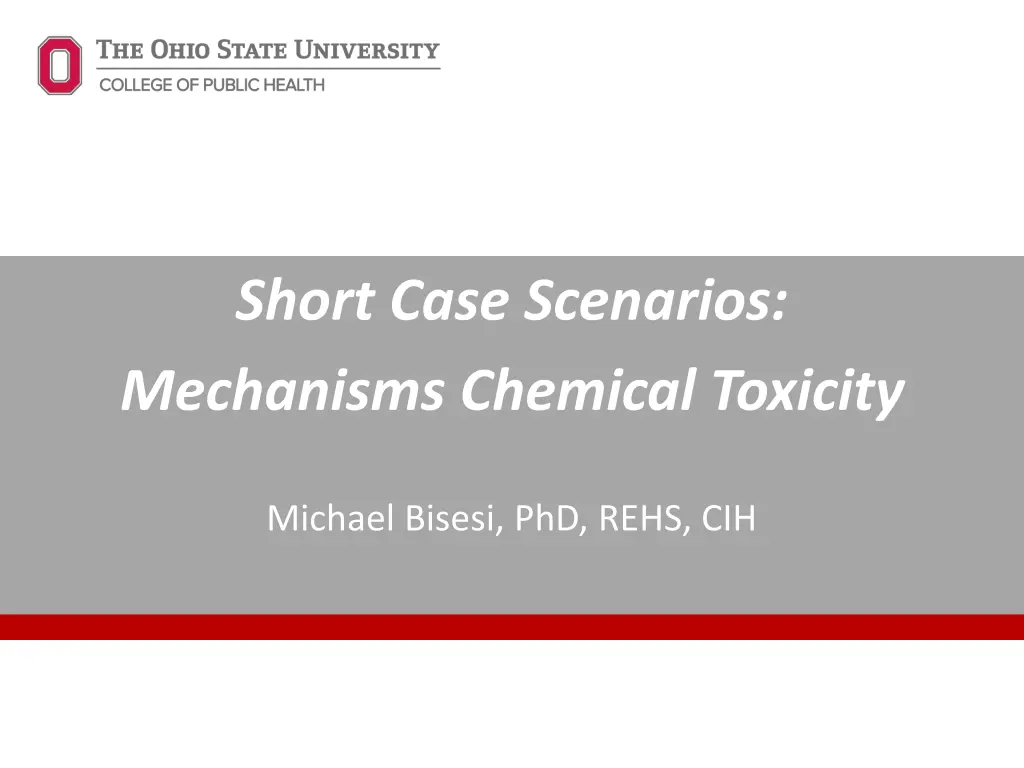
Understanding Mechanisms of Chemical Toxicity & Biochemistry
Explore short case scenarios illustrating enzyme inhibition, organophosphate toxicity, normal biochemistry of heme synthesis, porphobilinogen synthesis, and abnormal biochemistry due to Pb inhibition, as presented by Dr. Michael Bisesi. Learn about the impact of environmental factors on human health.
Uploaded on | 1 Views
Download Presentation

Please find below an Image/Link to download the presentation.
The content on the website is provided AS IS for your information and personal use only. It may not be sold, licensed, or shared on other websites without obtaining consent from the author. If you encounter any issues during the download, it is possible that the publisher has removed the file from their server.
You are allowed to download the files provided on this website for personal or commercial use, subject to the condition that they are used lawfully. All files are the property of their respective owners.
The content on the website is provided AS IS for your information and personal use only. It may not be sold, licensed, or shared on other websites without obtaining consent from the author.
E N D
Presentation Transcript
Short Case Scenarios: Mechanisms Chemical Toxicity Michael Bisesi, PhD, REHS, CIH
ENZYME Inhibition: Normal Hydrolysis of Acetylcholine (Ach) Catalyzed by Acetylcholine esterase (AChE) Acetylcholine (ACh) is an essential chemical neurotransmitter that transports neuronal signal across synapse from neuron to neuron Synapse H3C-(C=O)-O-CH2-CH2-N+-(CH3)3 + AChE + H2O ACh Acetylcholine (ACh) ACh Esterase H3C-(C=O)-OH + HO-CH2-CH2-N+-(CH3)3 Acetic Acid Choline
Short Case Study An agricultural worker responsible for spraying crops with an insecticide, was found in the barn suffering from headache, vomiting, urinary and fecal incontinence, excessive salivation and lacrimation, miosis, and generalized paralysis. He was rushed to the hospital ER where upon diagnosis he was treated. He eventually recovered. Assuming the disease was environmentally-related, what is a plausible causative agent and related mechanism of toxicity?
Answer: Organophosphate Toxicity (Parathion AChE Inhibition) S (OC2H5)2 N O P O2 Bioactivated Parathion O (OC2H5)2 N O P O2 Paraoxon Paraoxon Inhibits Acetylcholineesterase (AChE) by Bonding to and Phosphorylating the Amino Acid Serine O AChE-SerN CHC O CH2 OH O (OC2H5)2 Phosphorylation O P 2 Michael Bisesi, Ph.D.
Normal Biochemistry of Heme Synthesis Succinyl CoA + Glycine (ALA synthetase) Aminolevulinic acid (ALA dehydrase) Porphobilinogen ~Six additional steps (associated enzymatic catalysts ) Protoporphyrin IX (Ferrochelatase +Fe2+) Heme 141 Michael Bisesi, Ph.D.
Normal Biochemistry of Porphobilinogen Synthesis d-Aminolevulinic Acid + ALA dehydrase Porphobilinogen 142 Michael Bisesi, Ph.D.
Abnormal Biochemistry: Pb Inhibition of Porphobilinogen Synthesis d-Aminolevulinic Acid + ALA dehydrase + Pb inhibition of enzyme (ALAD-Pb) no synthesis of porphobilinogen, therefore no erythropoiesis decreased synthesis of RBCs increased d-ALA in blood and urine Anemia 143 Michael Bisesi, Ph.D.
Short Case Study Workers in a paint colorant mixing facility handled various organic solvents and dry mineral pigments. The pigments contained various metals such as zinc, chromium, lead, iron, and cobalt to name a few. During annual medical monitoring, the clinic determined based on CBC analyses that several of the workers were anemic. Assuming the disease was environmentally- related, what is a plausible causative agent and related mechanism of toxicity?
Answer: Lead Enzyme Inhibition Pb interferes w/ heme synthesis Heme Iron (Fe2+) Protoporphyrin IX Heme is essential for oxidative processes Oxygen transport via RBC Hemoglobin Mixed Function Oxidative and Cytochrome Oxidase Processes Others 140 Michael Bisesi, Ph.D.
Oxidation via Electron Transfer Classic example is oxidation of Iron (II) component of Hemoglobin (Hb-Fe2+) in erythrocytes (RBCs) to Iron (III) Methemoglobin (Hb-Fe3+) Formation of Oxyhemoglobin: RBC-Hb-Fe2+ + O2 RBC-Hb-Fe2+-O2 Nitrites, amines, nitro/nitroso compounds associated with methemoglobin formation Methemoglobin cannot transport oxygen to cells Chemical Asphyxiation
Short Case Study A six-month old infant living in a rural area exhibited signs of poor appetite, diarrhea, and bluish discoloration around her lips. The infant s sleeping habits were normal and diet consisted of a popular brand of powdered infant formula mixed with tap water derived from a ground water acquifer. Assuming the disease was environmentally- related, what is a plausible causative agent and related mechanism of toxicity?
Answer: Nitrite Methemoglobinemia Hemoglobin + Nitrite Methemoglobin NO- RBC-Hb-Fe3+ RBC-Hb-Fe2+ Methemoglobin + Oxygen RBC-Hb-Fe2+-O2 X O2 RBC-Hb-Fe3+ 2 Michael Bisesi, Ph.D.
Free-Radical Formation Free-radicals are molecules containing unpaired electron in outer orbital due to loss or gain of electron R R + e- or R + e- R
Short Case Study A woman retired several years ago after working almost 40 years at a dry cleaner. She recently died of liver disease and an autopsy showed marked hepatic steatosis and centrilobular necrosis. Indeed, she also had signs of cirrhosis. Interestingly, her kidneys also revealed indications of necrosis. Prior to the onset of diagnosable liver disease, her main health complaints tended to be neurologic. Assuming the disease was occupationally- related, what is a plausible causative agent and related mechanism of toxicity?
Answer: Carbon Tetrachloride Hepatotoxity (Cancer?) Enzyme + Substrate CCl4 P450 Enzyme-Substrate Complex P450 CCl4 Enzyme (E) + Product P450 CCl3 2 Michael Bisesi, Ph.D.
Answer (cont.): Trichloromethyl Radical is Converted to Trichloromethylperoxy Radical Trichloromethyl Radical + Oxygen CCl3 O2 Trichloromethylperoxy OOCCl3 2 Michael Bisesi, Ph.D.
Answer (cont.): Trichloromethyl and Trichloromethylperoxy Radicals Interact w/ Phospholipids in Cell Membranes Abstract Hydrogen from Membrane Phospholipids to form radical Phospholipid Radical interacts w/ O2 Lipid-C=C Lipid-C=C + O2 Lipid Peroxy Radical ( Peroxidation ) Lipid-COO
Short Case Study A furnace installer and repair worker with 18 years experience gradually developed chronic fatigue, weight loss, dry cough, and dyspnea. Radiologic findings showed pleural thickening, fibrosis and ferruginous bodies in his lungs. His fingers were clubbed. Assuming the disease was occupationally- related, what is a plausible causative agent and related mechanism of toxicity?
Answer: Asbestos Fibers Asbestosis Asbestos is a mineral containing metals that can catalyze the reaction ( Fenton ) that converts endogenously formed hydrogen peroxide in products that include a very reactive hydroxyl radical Thus, formation of free-radicals is one mechanism suggested that contributes to the toxicity of asbestos fibers. 2 Michael Bisesi, Ph.D.
Answer (cont.): Asbestos Fibers - Chemistry Chemistry of Amphiboles: Crocidolite Amosite Tremolite Antophyllite (Mg Fe)7Si8O22(OH)2 Actinolite Na2(Mg Fe)3Fe2Si8O22(OH)2 (Mg Fe)7Si8O22(OH)2 Ca2(Mg Fe)5Si8O22(OH)2 Ca2(MgFe)5Si8O22(OH)2 Chemistry of Serpentine: Chrysotile Mg3Si2O5(OH)4 2 Michael Bisesi, Ph.D.
Answer (cont.): Asbestos Fibers - Catalysis of Free-radical Formation Iron (II) + Hydrogen Peroxide H2O2 Fe2+ Iron (III) + Hydroxyl Radical + Hydroxyl Anion HO- HO Fe3+ 2 Michael Bisesi, Ph.D.
NOTE: Asbestos Fibrosis Inhaled fibers deposit in bronchi Macrophages engulf fibers via phagocytosis Macrophage lysomes containing digesting- enzymes rupture while attmpting to dissolve fibers Enzymes leak into cell and cause autolysis Cyclical process increased synthesis of collagen fibrosis or scarring decreased elasticity.
Immune - Hypersensitivity Large foreign molecules or Antigens , typically proteins, (e.g. pollen; dander) can stimulate immune system to synthesize Antibodies (immunoglobulins) Subsequent exposure to same Antigens elicits Antibodies to interact with Antigens Deactivation of Antigen Immune response associated with release of mediators causing bronchoconstriction, rhinitis, edema, etc. Chemicals that are associated with hypersensitivity or sensitization reactions typically must first bind with endogenous protein to form an Antigen. The chemical is referred to as a hapten .
Short Case Study A few workers at a bed mattress manufacturing facility complained that they have difficulty breathing when in the vicinity of the urethane foam manufacturing operations. Indeed, their symptoms resemble an asthmatic response marked by bronchoconstriction. In addition, their eyes and upper repsiratory system felt irritated. Assuming the disease was environmentally-related, what is a plausible causative agent and related mechanism of toxicity?
Answer: Toluene Diisocyanate (TDI) Sensitization TDI (hapten) + Protein Antigen + Protein Protein TDI Antigens Synthesis of Antibodies Protein Antibody Antigens and Antibodies form Conjugate Responses Response Protein Antibody 2
Electrophile Formation Molecules having an atom with a relatively positive charge (+) due to an electron deficiency Relatively positive (+) electrophilic molecule has affinity for relatively negative (-) regions of nucleophilic molecules
What is the difference between the terms genotoxic and nongenotoxic chemicals?
DNA Genetic Code Double-helix polymer Monomeric Structures: Deoxyribose Sugar Phosphate at C5 Nitrogenous Base (bonded to C1Deoxyribose) O N NH N O N NH2 -O P O- O O H H HOH H H 52 Michael Bisesi, Ph.D.
Genotoxic Chemical Chemical with affinity for DNA . . . Electrophilic Toxicant Electrophilic Toxicant (X) bonds with DNA ( Nucleophilic Biomacromolecule) Form Adducts (DNA-X) X - X alters DNA Mutation 47 Michael Bisesi, Ph.D.
Nongenotoxic (Epigenetic) Chemical Chemicals interact with endogenous biomolecules other than DNA . . . Chemicals interact w/ biochemical processes and/or biochemicals ( biomacromolecules ) causing adverse effect Proteins (including Enzymes) Lipids (including Cell & Organelle Membranes) 48 Michael Bisesi, Ph.D.
Toxicant-DNA Adduct: Aflatoxin B1-N7-Guanine Adduct OH Aflatoxin B1 H2N DNA Polymer 67 Michael Bisesi, Ph.D.
Mutagens and Manifestation of Mutational Aberrations: Mutagenic agents or mutagens are genotoxic agents that cause genetic aberrations Somatic Effect: aberration is manifested in the exposed individual alteration of somatic or body cells . . . (genotoxic carcinogenesis) Genetic (or Germinal ) Effect: aberration is expressed in the progeny of the exposed individual alteration of germ/sex cells (sperm or ova) 50 Michael Bisesi, Ph.D.
Result of Base-pair Substitution and Frame Shift Mutations Altered DNA encodes for wrong or no amino acid(s) Missense: Complete, but abnormal or nonfunctional synthesized protein Nonsense: Incomplete/truncated protein is nonfunctional 63 Michael Bisesi, Ph.D.
From: Rubin, E.and Farber, J.L. (1990). Essential Pathology. J.B. Lippincott Co., Philadelphia, PA.
Procarcinogen: Benzo(a)pyrene 75 Michael Bisesi, Ph.D.
Proximate (Intermediate) Carcinogen: Benzo(a)pyrene-7,8-epoxide O 76 Michael Bisesi, Ph.D.
Ultimate Carcinogen: Benzo(a)pyrene-7,8-diol-9,10-epoxide O HO OH 77 Michael Bisesi, Ph.D.
Short Case Study A 55 year-old petroleum refinery worker complains that she started bruising easily, is often tired, and recently has periodic nose bleeds. A chest x-ray was normal, but her hematologic results were abnormal. Assuming the disease was occupationally- related, what is a plausible causative agent and related mechanism of toxicity?
Answer: Benzene Leukemia Benzene is actually a procarcinogen that requires biotransformation to an active product. One suggested mechanism is formation of electrophilic metabolites that form DNA adducts Benzene is converted to an intermediate epoxide and then to phenol and some catechol and hydroquinone The phenolic metabolites are transported to the bone marrow and thought to form benzoquinone Electrophilic benzoquinone can covalently bond to DNA DNA Adduct Mutation/Cancer Other plausible mechanisms have been suggested, including formation of reactive free radicals 2 Michael Bisesi, Ph.D.
Answer (cont.): Benzene O OH OH OH OH + + OH O O + O O 2 Michael Bisesi, Ph.D.

